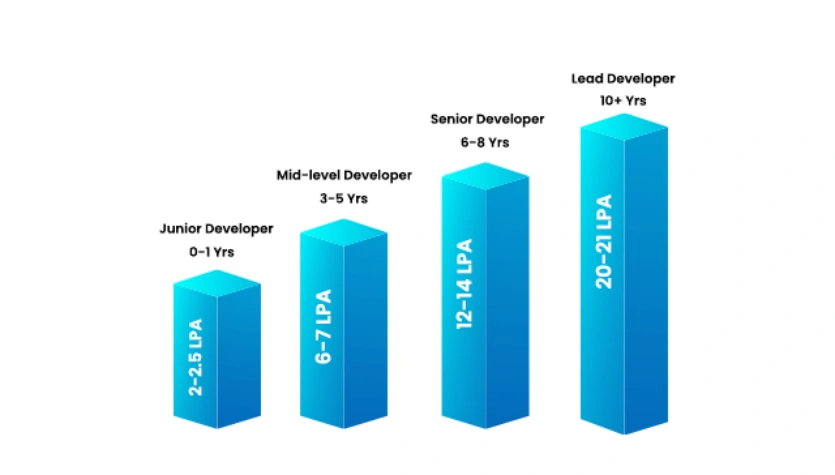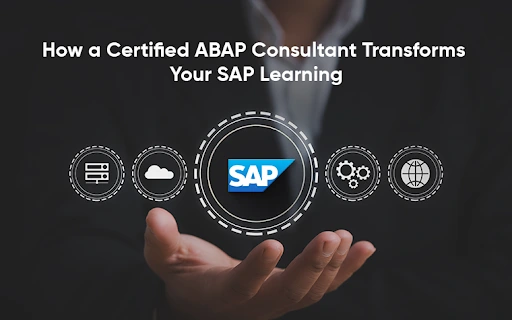
What Makes Fullstack Development The Right career?
Are you thinking of making a big career change? Or are you exploring more opportunities? Well, you’re at the right place! Read on to know if full stack development is the right career for you!
What Does a Full Stack Developer Do?
We all use apps, web pages, and websites daily. We order food, pay our electricity bills, or even play ‘Candy Crush’ on apps and websites that are now as much a part of our lives as breathing. But who creates these websites?
Behind these smooth experiences are full stack developers—the all-rounders of the IT profession.
Full stack developers are responsible for end-to-end functioning of applications. They work in the front end, and the back end of applications. They are also tasked with the debugging and smooth running of applications to make them user-friendly.
Let’s break it down further:
The frontend is the client side of the website or web application. Users of a webpage directly interact with the front end. Everything that you can see and use on a website or an application is programmed by a frontend developer. These professionals have a flair for design and creativity, as one of their key functions is to create websites that stand out.
Key full stack developer tools for frontend include:
- CSS
- HTML
- Javascript
- React.Js
Backend developers work on the server side- the backbone of every application. They handle applications’ inner functioning, from data transfer to security, using databases and logic. Some commonly used databases are MongoDB, MySQL, and so on. Backend developers have clear analytical minds, problem-solving skills, and strong coding skills.
Essential full stack developer skills for backend development include:
- Python
- JAVA
- C++
- Node.js
- HTML
- SQL
Backend developers create libraries that interact with the user’s browser. Databases simplify this process and allow for a much easier use of the website or application.
Some popular databases used are:
- MongoDB
- MySQL
- ORACLE
Both frontend developers and backend developers work together to bring an application or a website to life. Some developers can play the role of both, and they are the full stack developers.
Is Full Stack Developer in Demand?
Yes, full stack developers are in demand, and their popularity continues to rise. Professionals who are adaptable and able to work on different aspects of an application hold high value among the recruiters. Also, the job marketplace is always in need of full stack developers with the constant rise of internet users. According to the US Bureau of Labor Statistics, Full stack developers will see a rise of 27% in job demand by the end of 2024.
Companies mainly seek developers for their:
- Skillsets in software stacks like MERN, MEAN, LAMP, etc.
- Problem-solving capabilities
- Analytical thinking
- Critical thinking
Why Choose a Career in Full Stack Development?

High salary:
A career in full-stack development comes with its hurdles, but it has great rewards. The average salary of a fullstack developer is 7 LPA. Even freshers of the field make at least 3-4 LPA. And they also enjoy immense potential for increments with work experience.
Growth opportunities:
Fullstack development would be the right career for you if you’re looking for a stable career with growth opportunities. It is an ever-developing field with emerging technologies. People with a passion for learning and innovation are recommended to take up full stack development courses.
Future of Full Stack Developer Roles
The future of full stack developers looks promising, with growing demand across industries such as e-commerce, finance, healthcare, and IT. As technology advances, full stack developers will continue to lead innovation and digital transformation.
Multiple career paths:
As they have mastered entire tech stacks, full stack developers can not only work on all aspects of a project, they can also work in various jobs across the computer science field. A professional with full stack developer skills can choose to specialize in backend development, frontend development, DevOps engineering, software engineering, mobile app development, and more. And they can choose to make a career in IT, e-commerce, banking and finance, healthcare, and many other fields.
Still not convinced? Here are a few more reasons why a course in Full-stack development,Is full stack developer in demand?
Job security:
Fullstack developers enjoy job security. Companies value full-stack developers for the smooth running of their applications. This also comes with a lot of pay incentives. They’re the backbone of the website or application and hence, companies are rarely willing to part with these professionals.
It’s also a career that has immense possibilities for entrepreneurship. Those thinking of founding start-ups can consider this course.
Flexible working conditions:
Most jobs need a steady presence in a corporate workplace. But, full-stack developers can also work as freelancers. They can edit their work contracts to fit their work, time, and salary preferences.
Full Stack Developer Skills You’ll Need?
If you’ve decided to become a full-stack developer, you’ve got to begin somewhere. Let’s check out the steps to get started.
Learn the Basics
Here are some essential full stack developer skills:
- HTML/CSS: These are your building blocks for creating and styling web pages.
- JavaScript: JS will make web pages interactive.
- A Backend Language: Pick one (like Node.js, Python, Ruby, or Java) to manage server-side logic.
- Database Basics: Learn about SQL (for relational databases) or NoSQL (for non-relational databases) to store and manage data.
Pick Your Tech Stack
There are various types of full stack developers but a popular one is the MERN stack (MongoDB, Express.js, React, Node.js). Each part of the stack handles a different aspect of web development:
- MongoDB: A NoSQL database to store data.
- Express.js: A web application framework for Node.js to build server-side applications.
- React: A library for building dynamic user interfaces.
- Node.js: A runtime environment to execute JavaScript code on the server
Work on Full Stack Projects
Reading and watching tutorials is great, but nothing beats hands-on experience. Start with beginner-friendly full stack projects to apply your skills.Here are some ideas:
- To-Do List App: A simple project to get comfortable with CRUD operations (Create, Read, Update, Delete).
- Blog Website: Practice creating and managing content.
- E-Commerce Site: A more complex project that incorporates user authentication and payment integration.
As you advance, take on more complex full stack web development projects to showcase your abilities.
Upskilling Programs
Consider enrolling in upskilling programs or bootcamps to accelerate your learning. These programs often provide structured learning paths, mentorship, and real-world projects that can give you a competitive edge. Look for reputable online full-stack courses that offer hands-on training and career support.
So, are you ready to start your journey as a full stack developer? Take the first step today, and watch your career thrive



